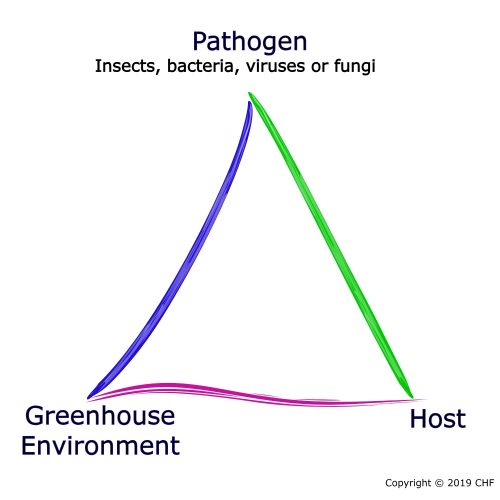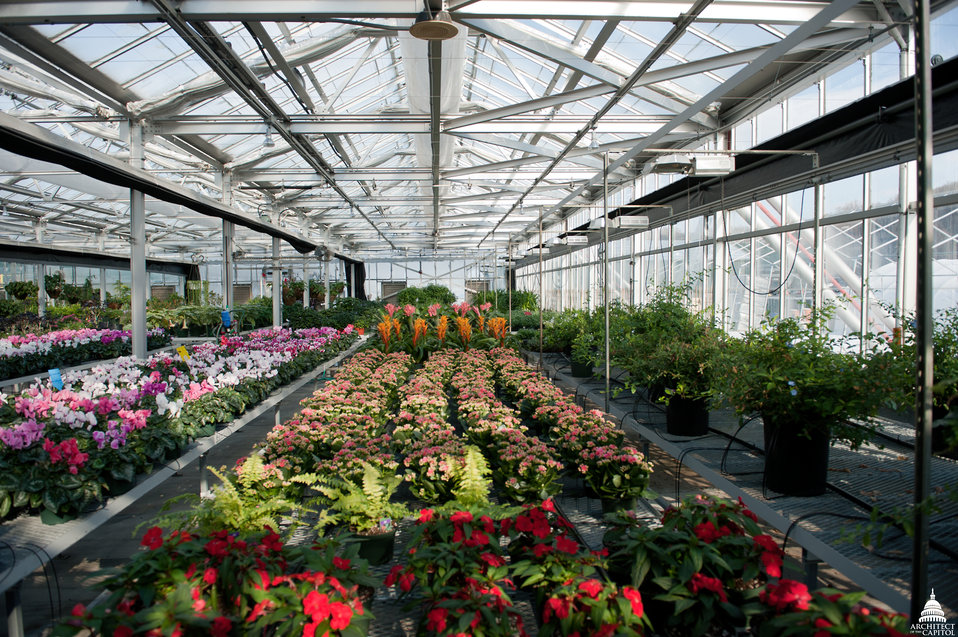Understanding the greenhouse environment
The protected greenhouse environment
The greenhouse environment is designed to allow plants to perform close to their genetic optimum so that the grower achieves maximum profit. A greenhouse is designed so that the plant converts sunlight, water and CO2 and minerals into marketable yield. Thus the protected greenhouse environment creates a “cozy” climate inside a harsh environment. If you already have a cozy climate, there is no need for an expensive smaller cozy climate to grow crops in.
Before the invention of greenhouses our diet was very seasonal, unless you had the money to purchase non-perishable produce that was imported from other climates. With the invention of protected environments more crops can be grown locally.
The main function of a greenhouse is to control temperature and humidity. Quite often poor design and placement of greenhouses cause endless problems with temperature and humidity. A well designed greenhouse should provide the right crops an ideal environment to achieve yields over a period of time that will make such an installation economical. Don’t think a greenhouse is magic, solving one problem just brings a host of others that need to be managed. This is where many beginners make a big mistake. Conditions that promote optimal growth for plants are just as favourable for pathogens and pests.
The most important greenhouse environmental factors are:
- Temperature
- Humidity
- Ventilation and air circulation
- Pest and disease pressure
- Environment for humans to work in
- Crop volume and density
Temperature and the greenhouse environment
The initial requirement or purpose of greenhouses was to increase the average temperature so crops could be grown in cold climates. The temperature differential between inside the greenhouse and outside was only limited to the amount of energy is used for heating. Natural heating from sunlight during the day time is caused by the alteration of the wavelength from about 340-374 nm to 3550-25,000 nm). The short wavelengths penetrate the greenhouse and once they bounce against objects their weave length change. The long wavelength rays cannot escape the greenhouse and thus they heat the air inside. That is the simplest form of natural heating. That is why a greenhouse will be hotter inside compared to the temperature outside even if it is freezing cold outside.
The temperature differential will again be determined by the material used to cover the greenhouse. I am not talking about vents and fans yet. The temperature in the middle of the greenhouse, or center, will always be higher than at the edges 1)E. Rico-Garcia, I.L. Lopez-Cruz, G. Herrera-Ruiz, G.M. Soto-Zarazua and R. Castaneda-Miranda, 2008. Effect of Temperature on Greenhouse Natural Ventilation under Hot Conditions: Computational Fluid Dynamics Simulations. Journal of Applied Sciences, 8: 4543-4551.. This is because air movement at the openings or edges prevent the center areas to move. Basically the center becomes stagnant.
With the advent of better designed and higher greenhouses, they have managed to lower the temperature inside compared to outside. Unfortunately there is a limit otherwise there would have had millions of greenhouse freezers in Africa. On average, with available technology, the temperature differential between inside and outside will not be more than 7°C if you are trying to cool down the greenhouse.
No greenhouse is perfect. There will always be microclimate variations and they will influence not only plant growth2)Lord Abbey & Sajjad Ali Rao. Differential response of plant species to greenhouse microclimate created by design technology and ambient conditions. Canadian Journal of Plant Science, 2018, 98(2): 300-308, but it will have an effect on pest and disease development. Take pythium for instance. It grows linearly below 22°C, but at higher temperatures, the growth is exponential. The practical implication is in some areas of your greenhouse you might have higher disease and pest pressure than others. It has a cost implication too. Is it really necessary then to spray the whole greenhouse if you knew this fact. Maybe yes, maybe no, but it’s better to find out and save money than sitting in front of you PC and reading this article. Efficiency of ventilation gets rather complicated depending on your climate. Optimum ratio of vent to surface roof area depends on your climate 3)Li, G., Tang, L., Zhang, X., Dong, J., Xiao, M. 2018. Factors affecting greenhouse microclimate and its regulating techniques: A review. 167. IOP Conference Series: Earth and Environmental Science. It ranges from 15-20% in tropical areas to 60% in very humid conditions. In most cases 30% will do the trick.
If we ignore vents, fans, pads, doors etc to manipulate the temperature inside the greenhouse, the following has an influence on the inside temperature during the day and night:
- Type of crop: is it a small crop such as lettuce or fast growing high climbing crop such as cucumbers. Small crops allow better air movement throughout the greenhouse but absorb less light from the sun. Crops with a high leaf area absorb more sunlight and radiate this heat out during the night. Large crops reduce air movement.
- What is the density of the leaves that occupy the volume under the greenhouse roof. Small dense leaves such as lettuce or a large volume of leaves going high up like cucumbers and brinjals.
- What material is used to cover the floor. The darker the material, the more light or heat is absorbed which will be radiated out during the night making the greenhouse warmer. White materials bounce the sun rays away but they also modify them so the plant can use it for photosynthesis. So what do you need more, heat or light. The problem for the grower is to determine a balance between the two. The more you can heat the greenhouse with the sun in cold temperatures, the less your own heating will cost. Unfortunately, cold temperatures are associated with less light, so you need more light bouncing material for photosynthesis. It is a conundrum that all growers face and it’s one that you have to solve over time.
- The greenhouse cladding has a significant effect on temperature since it determines which sun rays penetrate. The darker the cladding the less light goes through. Clear materials such as glass is not necessary the best. Some type of diffusion helps to increase the photosynthetic active radiation portion of the light, thus increasing the plants productivity.
- The angle of the land and the latitude of your location. This has to do with the angle the sun hits any surface inside your tunnel and the cladding. If the sun hits your ground at a 90° angle it will be hotter than when it hits it at 20°. Obviously this is when summer and winter comes into the frame does it not.
Temperature is the main factor that influences crop growth4)Pearson, S. 1992. Modeling the effect of temperature on the growth and development of horticultural crops.PhD theses, Reading University, 204pp.. Different crops have different optimum temperatures and they can vary at different growth stages. At the end, it’s a matter of management and compensation. It will never be perfect, that’s impossible. Whatever the outside temperature is, the greenhouse must be able to average out the inside temperature between 15-30°C. The range will shift slightly higher with tropical crops such as tomatoes, peppers and cucumbers and lower with lettuce, spinach and some herbs. The point is that the greenhouse must protect the crop from temperature extremes which cause stress and reduces yield.
Humidity inside a greenhouse
Just as temperature, humidity plays an important part in crop growth. Controlling humidity is often an art as it changes in the opposite direction that you want when trying to control temperature. For example, increasing the ventilation rate to lower temperatures will usually decrease humidity. This is often not the ideal result, especially working with cucumbers where high humidity is essential. Modern greenhouses are designed to be airtight (well, as much as possible). With modern greenhouses, humidity is much higher inside insulated greenhouses than conventional ones5)Hand, D.W. (1988). EFFECTS OF ATMOSPHERIC HUMIDITY ON GREENHOUSE CROPS. Acta Hortic. 229, 143-158 DOI: 10.17660/ActaHortic.1988.229.12. So with higher efficiency greenhouses better control and management is required for optimum temperature and humidity control.
So what causes humidity fluctuations inside a greenhouse.
First of all the plants. Plants evaporate huge amounts of water. A cucumber plant absorbs up to 3L/day. 95% of that water is used to cool itself down and the rest is used for metabolic processes. All that water is evaporated into the greenhouse which contributes significantly to the overall humidity. Cucumbers have a large leaf area index (LAI) for evaporation compared to a small crop such as lettuce. Smaller crops will have less effect on humidity buildup inside the greenhouse than large leafy crops.
The type of irrigation system used inside the greenhouse. A gravel culture system will evaporate more water into the atmosphere than a NFT system with a closed top. Bag culture systems also evaporate more water than Rockwool systems with a small inlet surface. With open irrigation systems there is effluent draining off in channels between plants. The open and moving water will evaporate quickly.
The colour of and temperature of the floor has an influence in evaporation rate. Hot water evaporates more quickly than cold water. So if your floor, bags, channels etc. are heated by sun radiation, the water inside will evaporate more quickly and contribute more towards humidity than cold ones.
The ideal design is where no water is lost due to evaporation of irrigation water. The only loss is through the plant but that is required. Although most horticultural crops can grow between RH of 55-95%, some crops tend to do better at higher humidities such as cucumbers. Tomatoes, peppers and brinjals tend to show blossom end rot symptoms if humidities are too high.
Humidity has an influence on the efficiency of plant cooling. The lower the humidity, the better the plant can cool itself down due to the water vapour gradient inside vs outside the plant. With low humidities water evaporates faster thus cooling the plant of more efficiently. High humidities result in water moving more slowly up and through the plant. It also means nutrients are moved slower from the roots to the shoots and fruit. That is why BER is a problem at high humidities.
Some growers require crops to grown at very high humidities or the greenhouse is placed in deserts with extremely low humidity and high temperature. In these cases misting or fogging systems are used to lower temperatures. Cooling is achieved by evaporating extremely small water droplets by spraying water under very high pressures. These systems provide better uniformity than pad and fan systems. The higher the pressure used to force the water droplets into the air the more efficient the system is6)Li, S. and Willits, D.H. 2008 Comparing low-pressure and high-pressure fogging systems in naturally ventilated greenhouses. Biosyst Eng.101(1) pp 69-77
Ventilation and air circulation
Ventilation and air circulation are two completely different things. Ventilation is used to either cool the greenhouse down and or to reduce the inside humidity. Ventilation can either be natural or forced. Air circulation is only important if you know that there are micro-climate pockets or uneven distribution of temperature/humidity inside the greenhouse. Natural ventilation is usually the first step in cooling since it is simple and little cost. Most growers try combining various methods of ventilation such as forced ventilation with fans. Internal circulation evens out the climate and provides more evenly matched yields of all the plants. Pan and fan systems is more about cooling than ventilation.
The efficiency of natural ventilation of a structure is something not a lot of growers contemplate on. But it is extremely important. If a greenhouse is highly efficient in cooling itself down, the cost of forced cooling is significantly reduced. If it is possible, the angle of the greenhouse positioned at prevailing winds can also significantly help ventilation efficiency. The sucking effect of air movement over the greenhouse can force the hot air out of the top vents and cooler moist air in at lower parts 7)Roy, J.C. and Boulard T. 2005. CFD prediction of the natural ventilation in a tunnel-type greenhouse: Influence of wind direction and sensibility to turbulence models. International Society for Horticultural Science (ISHS), 2005 Leuven, Belgium.
Pest and disease pressure
The greenhouse environment is a cosy place for any pest, bacteria or fungi. They have a perfectly control, very comfortable, non threatening environment in which they can flourish. This all sounds very daunting but there is light at the end of the tunnel. In order for a disease or pest to survive it needs three important things:
- There obviously needs to be a pathogen which can be one of the four; insects, bacteria, viruses or fungi
- A suitable environment
- A host to feed on.

The disease or pest triangle. For a pest or disease to flourish all three components must be available.
Both the environmental conditions and growing systems in greenhouses favour pest and disease development. This is not the case in open field conditions. In the open the climate or weather is significantly more variable and hosts are often not as ‘tasty’.
I will discuss the disease triangle in more detail, but some of the basics are as follows.
- Temperatures inside greenhouses rarely fall below 8-10°C. So very few diseases die of lower temperatures. Temperatures do sometimes go above 36°C which is detrimental to some insects but not always bacteria, fungi and viruses.
- There is hardly any air movement that we can call wind. So insects stay put where they are and populations tend to increase more rapidly than in open field conditions
- The greenhouse provides a limited environment to escape. Once the insects are inside they can only escape through very small openings. So they are confined in the greenhouse for the rest of their lives.
- Only one crop is grown in a greenhouse. That makes searching for food so easy.
- Greenhouse plants are more succulent than their counterparts in the open field making them easier targets for pests and diseases.
- There is always water somewhere in the greenhouse which is often a breeding ground for a lot of pests and diseases.
- Quite often there are less predators inside a greenhouse than outside. Since predators don’t find plants that they hide on inside, they have no reason to stay and fly out of vents as soon as they can. They are also killed during chemical application.
- The growth medium used in greenhouses are either sterilized or inert. So there are significantly less pathogens, eggs and parasites living in the growth medium than in open field conditions. This also means that once there is a pathogen, there is no competition to halt or reduce their numbers.
So if you think a greenhouse will host less pests and diseases you are in for a big surprise. Pests and diseases are a bigger problem inside a greenhouse than in the open field.
Planting density
Planting density inside greenhouses are much higher than in open field conditions. This is a necessity since the structure is expensive, running costs are much higher per plant and space is at a premium. The leaf canopy creates a microclimate with high humidity, reduced ventilation and increased temperature. Ideal for disease to develop and thrive. The plants are in close contact with each other, so searching for the next leaf or fruit is not a big issue. Transmission of spores, viruses, bacteria and some pests are easy, especially if they hitch a ride on human activity. Dense leaf canopies results in reduced light intensities at lower parts of the plant, leading to low light stress in the lower leaves. This makes them even more susceptible to disease and insect damage.
References
| ↑1 | E. Rico-Garcia, I.L. Lopez-Cruz, G. Herrera-Ruiz, G.M. Soto-Zarazua and R. Castaneda-Miranda, 2008. Effect of Temperature on Greenhouse Natural Ventilation under Hot Conditions: Computational Fluid Dynamics Simulations. Journal of Applied Sciences, 8: 4543-4551. |
|---|---|
| ↑2 | Lord Abbey & Sajjad Ali Rao. Differential response of plant species to greenhouse microclimate created by design technology and ambient conditions. Canadian Journal of Plant Science, 2018, 98(2): 300-308 |
| ↑3 | Li, G., Tang, L., Zhang, X., Dong, J., Xiao, M. 2018. Factors affecting greenhouse microclimate and its regulating techniques: A review. 167. IOP Conference Series: Earth and Environmental Science |
| ↑4 | Pearson, S. 1992. Modeling the effect of temperature on the growth and development of horticultural crops.PhD theses, Reading University, 204pp. |
| ↑5 | Hand, D.W. (1988). EFFECTS OF ATMOSPHERIC HUMIDITY ON GREENHOUSE CROPS. Acta Hortic. 229, 143-158 DOI: 10.17660/ActaHortic.1988.229.12 |
| ↑6 | Li, S. and Willits, D.H. 2008 Comparing low-pressure and high-pressure fogging systems in naturally ventilated greenhouses. Biosyst Eng.101(1) pp 69-77 |
| ↑7 | Roy, J.C. and Boulard T. 2005. CFD prediction of the natural ventilation in a tunnel-type greenhouse: Influence of wind direction and sensibility to turbulence models. International Society for Horticultural Science (ISHS), 2005 Leuven, Belgium |




